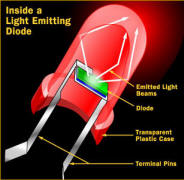What the heck is an LED anyway?
 Light
emitting diodes, commonly called LEDs, are real unsung heroes in the electronics
world. They do dozens of different jobs and are found in all kinds of devices.
Among other things, they form the numbers on digital clocks, transmit
information from remote controls, light up watches and tell you when your
appliances are turned on. Collected together, they can form the text and images
you see on an LED sign.
Light
emitting diodes, commonly called LEDs, are real unsung heroes in the electronics
world. They do dozens of different jobs and are found in all kinds of devices.
Among other things, they form the numbers on digital clocks, transmit
information from remote controls, light up watches and tell you when your
appliances are turned on. Collected together, they can form the text and images
you see on an LED sign.
Basically, LEDs are just tiny light bulbs that fit easily into an electrical
circuit. But unlike ordinary incandescent bulbs, they don't have a filament that
will burn out, and they don't get especially hot. They are illuminated solely by
the movement of electrons in a semiconductor material, and they last just as
long as a standard transistor.
Terminology
 EMC
- Electronic Messaging Centers are available in single color, full color and
full video options.
EMC
- Electronic Messaging Centers are available in single color, full color and
full video options.
Pitch - This is the spacing from center to center on the pixel You will
find that a smaller pitch will make the unit seem clearer from a closer
distance. Larger pitch is required for greater viewing distance.
Pixel Matrix ? number of pixels (H x W) that make up the display area.
Viewable Distance ? the rule of thumb is each inch of character
height will provide you with 35? of viewable distance
Exposed pixels - The exposed style will yield a wider viewing
angle while emitting a brighter image. This is especially noticeable in full
sunlight. It is also easier to cool because the LEDs are in the open air as
opposed to being inside the cabinet.
Protected pixels - The protected lexan (which is behind a lexan
face) face is also perfectly suitable and yields full sunlight readability. The
exposed style is more costly to manufacture, and therefore priced a bit higher.
We recommend this cluster when dealing with signs that are low to the ground.
More information to help you make your buying decision: